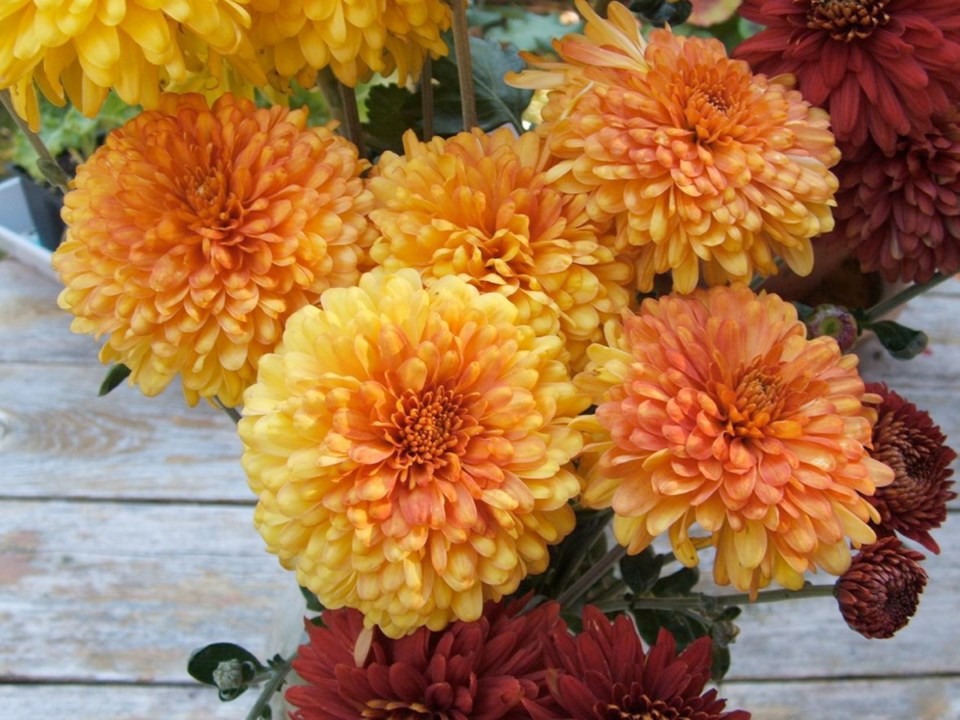A few weeks ago, I was working at my desk when I noticed a car parked in front of the house and two people walking up the driveway. The visitors were Jack MacAulay and his daughter.
Jack has long been associated with the Victoria Chrysanthemum Society. I’ve often been the grateful recipient of gorgeous bouquets of flowers from their shows in the fall.
Once we had exchanged warm greetings, they retreated to the car and brought out a big pail filled with “show” chrysanthemums that Jack had grown. We chatted in the kitchen as I arranged the blooms in two large vases.
There were several styles of flower, in colours ranging from pastel pink and yellow to rich bronzed orange and gold shades — autumn colours.
Like dahlias, “show” or florists’ chrysanthemums come in a range of flower styles. In the arrangement I made of pastel shades were pink, yellow, and creamy apricot blooms of my favourite type, the slightly shaggy ones with quill-shaped petals. Others were big ball-shaped blooms with incurved petals in white and yellow.
The other arrangement held the fall colours, most in the “spray” style of smaller flowers borne in clusters on a sturdy stem.
Certain of these chrysanthemums are suited best for growing as sprays; others are more commonly grown to produce large, exhibition type blooms.
To produce the big flowers, as flower buds develop on a stem, all the side buds are removed to leave a single terminal bud, which grows large as a result. A plant treated this way is termed a “disbudded” chrysanthemum.
An opposite procedure is used to grow “sprays.”
Stem tips are pinched out when they are around 25 centimetres tall. This promotes the production of branching stems that will bear many, smaller blooms.
These exhibition mums are different from the potted “garden” mums on display in the fall wherever plants are sold. The bushy, flower-packed plants are popular for creating a lovely show of autumn colour on decks, patios and balconies.
Growing the large disbud and spray styles of chrysanthemums used to be a passion of many home gardeners. Now, for various reasons that probably include the fast pace of crowded lives these days, fewer people practise this form of garden art.
The Victoria Chrysanthemum Society encourages interest in cultivating these beautiful flowers.
A good contact for information and for sources of plants is Jack MacAulay, at 250-656-2594 or je.maca@telus.net.
The society holds a sale of rooted cuttings in April. Their next meeting is on Saturday, Oct. 27, at 1647 Chandler Ave., starting at 2 p.m.
Exhibition chrysanthemums are grown from rooted cuttings, taken from shoots produced by the previous year’s plants (called “stools”) that have been stored over the winter.
Tips for the times
• Soil protection. It’s the time of year to think about protecting the soil in beds and plots emptied of annual flowers and summer vegetables. A soil cover of some sort helps to minimize the leaching and erosion effects of hard fall and winter rains.
Leaves or chopped straw are commonly used for this purpose. Except for sites to be planted in potatoes or strawberries in the spring, lime the soil before laying the protective mulch.
• Bulbs. To round out your garden’s collection of hardy spring-flowering bulbs, why not try something different, like a green-flamed (Viridiflora) tulip? These stately and long-lasting tulips extend the flower-bulb season into late May.
Fritillarias bring unusual and artistically appealing blooms to the garden.
Commonly available is Fritillaria meleagris (chequered lily, snake’s-head fritillary, guinea hen flower).
The nodding blooms have a checkerboard purple and white pattern. There is an all-white form as well.
Garden events
Orchid meeting. The Victoria Orchid Society will meet on Monday, Oct. 22, at 7:30 p.m. in Gordon Head United Church Hall, 4201 Tyndall Ave. Wenqing Perner, an internationally acclaimed speaker in the field of orchid conservation and propagation, will speak about Paphiopedilum in China, ending with a 10 minute Biotech talk. Guests are welcome.
View Royal meeting. The View Royal Garden Club will meet on Wednesday, Oct. 24, at 7:30 p.m. in Wheeley Hall, 500 Admirals Rd. Cim MacDonald, photographer, author, artist and teacher, will present “Developing an artist’s eye when taking garden photographs.” Cim MacDonald is curator of the Chemainus Festival of Murals Society. Some of her work will be on display for sale. The evening will also include a judged mini show of exhibits from members’ gardens and a sale of plants and garden items. Drop-in fee $5.



